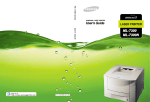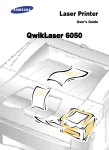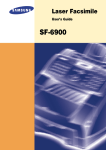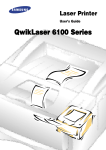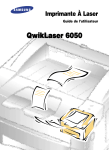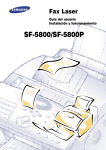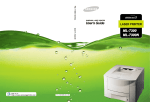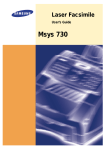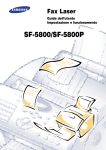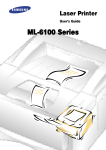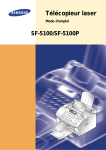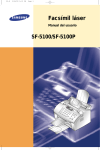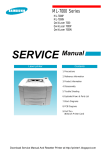Download Samsung ML-5200A User's Manual
Transcript
LASER PRINTER User’s Guide ML-5200A This manual is provided for information purposes only. All information included herein is subject to change without notice. Samsung Electronics is not responsible for any damages, direct or indirect, arising from or related to use of this manual. © 2000 Samsung Electronics Co., Ltd. All rights reserved. • ML-5200A and Samsung logo are trademarks of Samsung Electronics Co., Ltd. • Centronics is a registered trademark of Centronics Data Computer Corporation. • PCL is a registered trademark of Hewlett-Packard Company. • IBM, IBM PC are registered trademarks of International Business Machines Corporation. • True Type is a registered trademark of Apple Computer, Inc. • Microsoft, MS-windows, MS-DOS are registered trademarks of Microsoft Corporation. • All other brand or product names are trademarks or registered trademarks of their respective companies or organizations. Contents Chapter 1 Setting up your printer Unpacking –––––––––––––––––––––––––––––––––– 1.1 Selecting a location ––––––––––––––––––––––––––– 1.1 Understanding the printer parts –––––––––––––––– 1.2 Installing the toner cartridge ––––––––––––––––––– 1.4 Loading paper ––––––––––––––––––––––––––––––– 1.6 Connecting the printer to your computer –––––––– 1.8 Attaching the power cord –––––––––––––––––––– 1.10 Printing a test page ––––––––––––––––––––––––– 1.11 Software installation ––––––––––––––––––––––––– 1.12 Installing printer driver –––––––––––––––––––––– 1.12 Installing printer utilities ––––––––––––––––––––– 1.16 Making an installation diskette–––––––––––––––– 1.18 Uninstalling the printer driver –––––––––––––––– 1.19 Chapter 2 Operating your printer The Control Panel –––––––––––––––––––––––––––– 2.1 Selecting paper type and feed source ––––––––––– 2.3 Loading a stack of paper –––––––––––––––––––––– 2.4 Using the manual paper feeder –––––––––––––––– 2.8 Paper guidelines –––––––––––––––––––––––––––– 2.10 Selecting your printer ––––––––––––––––––––––– 2.11 Printing a document –––––––––––––––––––––––– 2.12 Print settings ––––––––––––––––––––––––––––––– 2.13 Printing on network printer –––––––––––––––––– 2.21 Remote Control Panel (only for DOS users) ––––– 2.22 i Chapter 3 Maintenance Resetting the printer ––––––––––––––––––––––––– 3.1 Cleaning the printer –––––––––––––––––––––––––– 3.2 Managing the toner cartridge –––––––––––––––––– 3.3 Adding printer memory –––––––––––––––––––––– 3.6 Chapter 4 Troubleshooting Clearing paper jams –––––––––––––––––––––––––– 4.1 Tips for avoiding paper jams –––––––––––––––––– 4.4 Fixing problems ––––––––––––––––––––––––––––– 4.5 Before you call service ––––––––––––––––––––––– 4.11 Chapter 5 Appendix FCC regulations ––––––––––––––––––––––––––––– 5.1 Canadian radio interference regulations –––––––– 5.1 EC declaration of conformity –––––––––––––––––– 5.2 Laser safety statement –––––––––––––––––––––––– 5.3 Safety information ––––––––––––––––––––––––––– 5.4 Specifications –––––––––––––––––––––––––––––––– 5.5 Index ––––––––––––––––––––––––––––––––––––––– 5.6 ii 01-Setup 3/2/00 9:43 AM Page 2 Chapter 1 Setting up your printer 01-Setup 3/2/00 9:43 AM Page 3 Unpacking Take out the printer and all accessories from the packing carton. Save the carton and packing materials in case you need to repack the printer. Make sure you have the following items: • Toner cartridge • Power cord • Setup CD-ROM • Paper exit tray • This manual • Centronics-compatible parallel interface cable (IEEE 1284-compliant) Notes: If you need help during setup, or if any items are missing or damaged, notify your dealer immediately. Selecting a location Place your printer on a sturdy, level surface near your workstation. Leave enough space around the printer so you can easily: • open the printer cover • load the paper • retrieve the paper • allow air circulation around the vents to prevent overheating Do not place the printer: • In direct sunlight • Near heat sources or air conditioners • In dusty or dirty environments Setting up your printer 1.1 01-Setup 3/2/00 9:43 AM Page 4 Understanding the printer parts Use figures on page 1.2 through page 1.3 to identify the main components of your printer. Front view Automatic paper feeder Manual paper feeder Paper tray Paper exit tray Paper guides Control panel Output lever Face-down output stacker Face-up output slot 1.2 Setting up your printer 01-Setup 3/2/00 9:43 AM Page 5 Rear view USB port Power switch Printer cable connector Power cord connector Inside Toner cartridge Front cover Setting up your printer 1.3 01-Setup 3/2/00 9:43 AM Page 6 Installing the toner cartridge 1. To open the printer cover, hold the cover using both hands and pull it toward you. 2. Unpack the toner cartridge, and carefully pull the sealing tape completely out of cartridge. 3. Rotate the cartridge 2 or 3 times to redistribute toner. 1.4 Setting up your printer 01-Setup 3/2/00 9:43 AM Page 7 4. Locate the cartridge slots inside the printer (one on each side). 5. Grasp the handle and slide the cartridge into the toner cartridge slots until it drops into place. Handle 6. Close the cover. Setting up your printer 1.5 01-Setup 3/2/00 9:43 AM Page 8 Loading paper For best results, use high quality 75g/m2 (20 lb) photocopy paper. Note: For more information on loading paper and other print material, refer to ‘Loading a stack of paper’ on page 2.4. 1. Pull the paper tray on the automatic paper feeder up until it stops. 2. Before loading the paper, flex the sheets back and forth to loosen and fan. Tap the edges on a table top to straighten. Doing this before you load paper helps prevent paper jams. Do not over fill the feeder. The feeder holds up to 150 sheets. 3. Insert the paper in the automatic paper feeder. If the paper has a preferred print side, place the print side towards you. Load letter-head paper facing you, with the top of the sheet toward the printer. 1.6 Setting up your printer 01-Setup 3/2/00 9:43 AM Page 9 4. Adjust the paper guides to the width of the paper. Paper guide Paper guide 5. Put the paper exit tray on the face-down output stacker and keep the output lever up. The face-down output stacker holds up to 100 printed pages. Output lever Setting up your printer 1.7 01-Setup 3/2/00 9:43 AM Page 10 Connecting the printer to your computer Your printer has a parallel interface port which allows you to use IBM PCs and compatible computers. Your printer also has a universal serial bus (USB) port. The universal serial bus is an interface which allows the printer to be connected to multiple peripheral devices. If your PC has a USB port, you can connect your printer to your PC by using a USB interface. Using parallel port You should use a Centronics parallel interface cable that supports bidirectional communications (IEEE-1284 compliant). Ask your dealer for assistance if you need help selecting the correct cable. 1. Make sure that both the printer and the computer are turned off. 2. Plug the parallel interface cable (printer cable) into the connector on the back of the printer. Push the clips at each end of the connector into the notches on the parallel interface cable. The clips snap into place when pushed into the notches. 3. Plug the other end of the parallel interface cable into the parallel connector on your computer. 1.8 Setting up your printer 01-Setup 3/2/00 9:43 AM Page 11 Using USB port USB port requires USB v1.0-compliant cable. Ask your dealer for assistance if you need help selecting the correct cable. 1. Make sure that both the printer and the computer are turned off. 2. Plug the USB cable into the connector on the back of the printer. 3. Connect the other end of the cable to the USB port on your computer. See your computer documentation for further assistance. Note: To print using USB interface, you must install the USB driver. See page 1.16. Setting up your printer 1.9 01-Setup 3/2/00 9:43 AM Page 12 Attaching the power cord 1. Plug one end of the power cord into the connector at the back of the printer, and the other end into a wall outlet. 2. Turn the printer on. As the printer powers up all control panel lights turn on briefly. 1.10 Setting up your printer 01-Setup 3/2/00 9:43 AM Page 13 Printing a test page After installation, you may run a simple test on your machine by printing a test page. 1. When only the READY light is on, press and hold the button for about 2 seconds. ERROR PAPER READY 2. When all the indicators blink, release the button. A demo page will print out. If you press and hold the button for over 4 seconds, a configuration sheet of the user default settings, the installed options, and the amount of printer memory available will print. Note: If this does not happen, re-check the installation. Setting up your printer 1.11 01-Setup 3/2/00 9:43 AM Page 14 Software installation Included with your printer is a CD-ROM containing printer drivers for the most popular Windows software applications. To operate your printer, you must install a printer driver which translates data from your application into data the printer understands. The CD-ROM shipped with your printer contains the following printer drivers and utilities. • PCL 5e printer driver • PCL 6 printer driver • USB driver which allows your printer to connect USB peripheral. • Remote control panel (only for Dos users): allows you to set up your printer to work properly with DOS applications. Installing printer driver System requirement Before you start, make sure you have the following computer requirement. (These are the minimum requirements.) • IBM or compatible with a 486 or higher processor • Windows 95, Windows 98, Windows 3.1, Windows 3.1x or Windows NT • Free disk space of at least 50 MB • Windows 3.1/3.1x: 8 MB or higher RAM Windows 95/98/NT 4.0: 16 MB or higher RAM • CD-ROM drive 1.12 Setting up your printer 01-Setup 3/2/00 9:43 AM Page 15 Windows 95/98/NT4.0 installation 1. Make sure that the printer is plugged in and connected to your computer. Turn the printer and the computer on, then start Windows. If Windows 95/98 recognizes the new printer, go to the section “Windows 95/98 plug and play” on page 1.14. 2. Insert the setup CD-ROM into your CD-ROM drive. The SAMSUNG PRINTER SETUP window opens. If Windows does not automatically run the CD-ROM: 1) Select Run from the Start menu. 2) Type d:\cdsetup.exe on the command line (where “d” is your CD-ROM drive letter), then click OK. 3. Select the appropriate language. Setting up your printer 1.13 01-Setup 3/2/00 9:43 AM Page 16 4. Select Install the Samsung Software on your PC. 5. Follow the instructions on the screen to complete the installation. Windows 95/98 plug and play 1. At the ‘New Hardware Found’ dialog box, click on the OK button. 2. Insert the setup CD-ROM into your CD-ROM drive. 3. Follow the instructions on the screen to complete the installation. 1.14 Setting up your printer 01-Setup 3/2/00 9:43 AM Page 17 Windows 3.1x installation 1. Make sure that the printer is plugged in and connected to your computer. Turn your printer and computer on. 2. Insert the setup CD-ROM disk into your CD-ROM drive. 3. From the Program Manager window, select File, and Run. 4. Type d:\cdsetup.exe on the command line (where “d” is your CD-ROM drive letter) and click OK. The SAMSUNG PRINTER SETUP window opens. 5. Select the appropriate language. 6. Select Install the Samsung Software on your PC. 7. Follow the instructions on the screen to complete the installation. Setting up your printer 1.15 01-Setup 3/2/00 9:43 AM Page 18 Installing printer utilities Installing the USB port driver The USB port driver must be installed to print to your printer via a USB connection. 1. Insert the CD-ROM in to your CD-ROM drive. If Windows automatically runs the CD-ROM, skip to step 3. 2. Select Run from the Start menu. 3. Type d:\cdsetup.exe on the command line (where ‘d’ is your CD-ROM drive letter), and click OK. The SAMSUNG PRINTER SETUP window opens. 4. Select the appropriate language. 1.16 Setting up your printer 01-Setup 3/2/00 9:43 AM Page 19 5. Click Install the USB driver on your PC. 6. Follow the instructions on the screen to complete the installation. Note : You can install the USB driver in the Windows 98. Installing RCP (only for Dos users) The RCP (Remote Control Panel) allows the Dos users to set default printer values. This utility can only be used when the printer is connected via the parallel interface. 1. Insert the setup CD-ROM into your CD-ROM drive. 2. In the DOS prompt C:\>, type “xcopy d:\5200\eng\rcp\*.* c:\prtutil” (where “d” is your CD-ROM drive letter) in the command line, and press Enter. The DOSRCP file is copied into the PRTUTIL directory. Setting up your printer 1.17 01-Setup 3/2/00 9:43 AM Page 20 Making an installation diskette Use the following procedures to copy software installation files from the setup CD-ROM onto floppy diskettes for installation onto computers that do not have a CD-ROM drive. 1. Label a new or formatted diskette “ML-5200A Driver” and insert it into the floppy drive. 2. Insert the setup CD-ROM into the CD-ROM drive. 3. Select the language from the SAMSUNG PRINTER SETUP window, then click Make your own Diskette set of software. 4. Select the disk image, then Copy selected disk images or Copy all disk images. 5. When copying is done, click Close. 1.18 Setting up your printer 01-Setup 3/2/00 9:43 AM Page 21 Uninstalling printer driver An uninstall utility is supplied with the printer driver to enable you to remove the driver and all associated files from your hard disk if so required. To uninstall the driver, proceed as follows: 1. Windows 95/98/NT 4.0: From the Start menu, select Programs, Samsung ML-5200A, then Samsung ML-5200A Driver Uninstall. Windows 3.1x: From the Program Manager window, double-click Samsung ML5200A, then Samsung ML-5200A Driver Uninstall. 2. When your computer confirms your selection, click Yes. The printer driver and all its components are removed from your computer. 3. When uninstalling is done, click OK. 1.19 02-Operating 3/2/00 9:35 AM Page 2 Chapter 2 Operating your printer 02-Operating 3/2/00 9:35 AM Page 3 The Control Panel The control panel has three indicator lights and one button. Depending on the light sequence, pressing the button activates different printer functions, such as resetting the printer, or running self-test. ERROR PAPER READY Indicator lights Indicator READY ERROR PAPER All lights Status Description On The printer is ‘ON’. Blinking The printer is receiving or processing data. Off The printer is off-line. On • There is no toner cartridge installed or the cover is open. • A printing error has occurred. • If the PAPER light is also on, there is a paper jam. Blinking Not enough printer memory to print On The paper bin is empty Blinking The printer is in manual feed mode and waiting for you to feed paper into the manual paper feeder. Blinking A system error has occurred. Operating your printer 2.1 02-Operating 3/2/00 9:35 AM Page 4 Button function Function 2.2 Usage On-line/Off-line Toggles the printer between on-line (READY light on) and off-line (READY light off) status. Manual feed start When you select `Manual Feeder’ source in the printer driver’s properties, you should press the button each time you feed a sheet of paper manually. See page 2.8. Reset Press the button to turn the printer off-line. With the READY light off, press and hold down the button until all lights are blinking, then release the button. The printer clears all data from the printer’s memory, and then restores the default settings. See page 3.1. Self-test With the printer on-line , press and hold down the button until all three lights are blinking, then release the button. A demo page will be printed. See page 1.11. Toner cartridge cleaning While the printer is on-line, press and hold down the button until all three lights remain lit and the printer starts feeding paper, then release the button. One sheet with the toner particles on the cartridge will be printed out. Operating your printer 02-Operating 3/2/00 9:35 AM Page 5 Selecting paper type and feed source One of the most important things you can do to obtain the best results from your printer is to select the correct type of paper. Your printer produces letter quality output on most plain bond papers, including cotton bond and photocopying papers. It does not require special paper, however, print quality varies with different paper types. You can print on any of the following materials: Type Plain paper (16 to 24 Ib) Size Feed Source Letter: 8 1/2 x 11” Legal: 8 1/2 x 14” Automatic feeder Executive: 7 1/4 x 10 1/2” A4: 210 x 297 mm A5: 148 x 210 mm B5: 182 x 257 mm Manual feeder Folio: 8 1/2 x 13” Custom size Capacity 150 sheets (approx.) 1 sheet Automatic feeder 10 envelopes (approx.) Manual feeder 1 envelope Transparencies Automatic feeder 10 items (approx.) Film paper labels Manual feeder 1 item Envelopes COM-10: 4 1/8 x 9 1/2” Monarch: 3 7/8 x 7 1/2” C5: 162 x 229 mm C6: 114 x 162 mm DL: 110 x 220 mm Notes: •When you print, select the correct paper size and source in your application. •Depending on the thickness of the material, the maximum capacity may be reduced. Operating your printer 2.3 02-Operating 3/2/00 9:36 AM Page 6 Loading a stack of paper You can stack paper, envelopes, card stocks, labels or transparencies in the automatic paper feeder. The automatic paper feeder holds up to 150 sheets of plain paper or 10 envelopes or other material. The maximum capacity may be reduced, depending on the thickness of the material. Note: If you experience feeding problems, try feeding a single sheet of paper from the manual paper feeder. See page 2.8. 1. Pull the the paper tray on the automatic paper feeder up until it stops. 2. Prepare the print material for loading. • For paper and envelopes: - Flex paper back and forth, or fan envelopes. Do not fold or crease the paper. Straighten the edges on a level surface. Note: If envelopes jam while printing, try reducing the number of envelopes in the automatic paper feeder. 2.4 Operating your printer 02-Operating 3/2/00 9:36 AM Page 7 • For transparencies: - Hold the transparencies by the edge and avoid touching the print side. - Fan the stack of transparencies to prevent feeding failures. Be careful not to scratch or leave fingerprints on the print side. 3. Load the print material in the automatic paper feeder without overloading. Do not mix different types of material. Read the instructions below on how to load each type of material. • Load paper or transparencies with the print side facing you. Place the print side facing you. Operating your printer 2.5 02-Operating 3/2/00 9:36 AM Page 8 • Load envelopes with the flap side facing away from you. Make sure the stamp area is on the bottom of the right corner. The end of the envelope with the stamp area enters the feeder first. Notes: • Do not feed stamped envelopes. The stamp is shown here for placement purpose only. • Never use envelopes with clasps, snaps, windows, coated lining or self-stick adhesives. These envelopes may severely damage the printer. • Load letterhead paper facing you with the top of the sheet toward the printer. AD RHE Operating your printer LETT E 2.6 02-Operating 3/2/00 9:36 AM Page 9 4. Adjust the paper guides to the width of the print material. Slide the guides until they lightly touch the stack of print material. Do not bend the print material. Paper guide Paper guide 5. Before starting your print job, make sure that you select the correct paper size and feed source for your application. Operating your printer 2.7 02-Operating 3/2/00 9:36 AM Page 10 Using the manual paper feeder When you print on envelopes, heavier weight paper, transparencies, index card, or paper labels, use the manual paper feeder to feed one sheet at a time. The manual paper feeder is in front of the automatic paper feeder. Automatic paper feeder Manual paper feeder 1. Push the output lever down. The paper will print out with the printed side facing up. Output lever 2. Load the print material in the manual paper feeder and adjust the paper guides to the width of the print material. See the instructions on how to load each type of material on page 2.4. 2.8 Operating your printer 02-Operating 3/2/00 9:36 AM Page 11 3. Before starting your print job, make sure that you select the correct paper size and feed source in your application. See ‘Print settings’ on page 2.13. 4. Send the data to the printer from the application. When all the data is transmitted, the PAPER light blinks. 5. Press the button on the control panel. Printing starts. 6. If you have more than one page to print, when the PAPER light blinks, load next sheet and press and hold the button for about 2 seconds until the printer pulls in the paper and starts printing. Note: If you press the button without any paper in the manual feeder, the printer will automatically use paper in the automatic paper feeder. 7. The paper exits through the face-up output slot with the printed side up. ERROR PAPER READY Notes: • The face-up output slot may not hold the printed pages properly. • The printed pages will not stack in the face-down stacker unless you change the output lever position. After you finish using the face-up output slot, you must change the position of the output lever to the normal position by pushing up. Operating your printer 2.9 02-Operating 3/2/00 9:36 AM Page 12 Paper guidelines When selecting or loading paper, envelopes or other special media, keep these guidelines in mind: • Attempting to print on damp, curled, wrinkled or torn paper can result in paper jams and poor print quality. • Use cut-sheet paper only. Do not use multipart paper. • Use only high quality, copier grade paper. Avoid paper with embossed lettering, perforations or texture that is too smooth or too rough. • Colored paper should be of the same high quality as white photocopy paper. Pigments must withstand the printer’s fusing temperature of 392 o F (200 oC) for 0.1 second without deterioration. Do not use paper with a colored coating that was added after the paper was produced. • Pre-printed forms must be printed with non-flammable, heat-resistant inks that do not melt, vapourize, or release hazardous emissions when subjected to the printer’s fusing temperature (approximately 392 oF, 200 o C) for 0.1 second. • Store paper in its ream wrapper until you are ready to use. Place cartons on pallets or shelves, not on the floor. Do not place heavy objects on top of the paper, whether it is packaged or not. Keep paper away from moisture or other conditions that can cause wrinkling or curling. • During storage, use moisture-proof wrap (any plastic container or bag) to prevent dust and moisture from contaminating the paper. • Always use paper and other materials that conform to those listed on page 2.3. • Use only well-constructed envelopes with sharp, well creased folds. - DO NOT use envelopes with clasps or snaps. - DO NOT use envelopes with windows, coated linings, self-stick adhesives or other synthetic materials. - DO NOT use damaged or poorly made envelopes. • For best results, use high quality 75g/m2 (20 lb) photocopy paper. 2.10 Operating your printer 02-Operating 3/2/00 9:36 AM Page 13 Selecting your printer To use all of the features of your Samsung ML-5200A printer, make sure it is selected as the default printer. When you install the printer driver, Samsung ML-5200A is automatically set as the default printer. If you use more than one printer, select ML-5200A as the default printer as follows: Windows 95 / 98 / NT 4.0 1. Select Start, Settings, then Printers. 2. Double-click Samsung ML-5200A PCL 5e or Samsung ML-5200A PCL 6. 3. From the Printer menu, select Set As Default. Windows 3.1x 1. In the Main program group, double-click the Control Panel icon. 2. Double-click the Printers icon. 3. Select Samsung ML-5200A PCL 5e or Samsung ML-5200A PCL 6. 4. From the Printers menu, click Set As Default Printer. Operating Your Printer 2.11 02-Operating 3/2/00 9:36 AM Page 14 Printing a document This procedure describes the general steps involved in printing from various Windows applications. The exact steps may vary depending on the application you are using. Refer to your application’s documentation for the exact printing procedure. 1. Start the program you are using to create a document or open an existing document you want to print. 2. From the File menu, choose Print or Print Setup. The Print or Print Setup dialog box appears in which you can change the printer settings. 3. If you click Properties, Setup, or Options in the dialog box, you will access the printer driver to make any necessary changes. See ‘Print settings’ on page 2.13. The settings can be changed depending on the printer selected. 4. Choose OK to close the dialog box. 5. Make any necessary changes to the print parameters and choose OK to start the print job. Note: The way you access the printer driver varies depending on the programs you use. 2.12 Operating your printer 02-Operating 3/2/00 9:36 AM Page 15 Print settings Most Windows applications allow you to make changes to the printer settings. This changes the number of copies, sequence of the pages, paper orientation, and margins. If you click Properties, Setup, or Options in the Print dialog box, you’ll access the printer driver’s dialog box. It allows you to change additional printer settings. Note: Most Windows applications will override settings you specify in the printer driver. Change all printer settings available in the software application first, and any remaining settings with the printer driver. PCL 6 printer driver Samsung ML-5200A PCL 6 printer driver shows the dialog box as shown below. It includes 7 tabs. Operating your printer 2.13 02-Operating 3/2/00 9:36 AM Page 16 Paper tab Menu Option Functions Copies (1-999) Sets the number of copies to be printed for each page. Paper orientation Sets the orientation (printing direction) of the print media. Select Landscape to run the printing parallel to the short edge of the print material. Select Portrait to run the printing parallel to the long edge of the print material. Paper source Allows you to set your printer’s default input tray or option. The default selection is Automatic Feeder. Select Manual Feeder when manually feeding a sheet of print material through the manual feeder. For information on the manual feeder, see page 2.8. Paper size Sets the print media size. The list box provides a summary of all the paper sizes supported by the printer driver and printer combination. Paper type Selects the type of print material, like Plain Paper, Envelope, Transparency and so on, installed in each paper source. If you use thick paper, set this to Bond. If you use card paper, set this to Card Stock. If you use colored paper having pigment or dyes as a part of the paper manufacturing process, set this to Colored paper. Select Letterhead for the paper having pre-printed logo or text located at the top of the page, Pre-printed for forms having some type of printing on them before they are sent through the printer. 2.14 Operating your printer 02-Operating 3/2/00 9:36 AM Page 17 Graphics tab Menu Option Functions Resolution Sets the print resolution. The higher the setting, the sharper the clarity of printed characters and graphics. For best results, set this to 600 dpi. For faster printing and smaller memory requirements (and a lower quality), use 300 dpi instead. SRT mode Allows you to select the print quality of your text output. SRT (Samsung Resolution Enhancement Technology) produces print with smooth angles, curves and edges. Image Enhance is available only when you set the resolution to 600 dpi. Toner save mode When this is checked, the printer uses less toner to print the document. The output is a little lighter, but you can extend the life of the toner cartridge. Graphics mode Sets how to send graphic information to the printer. All graphics can be printed as Raster images, however, some geometric shapes or patterns print faster if they are printed as Vector graphics. The vector setting usually provides faster printing speed, but some vector formatted images may not print as they appear on your computer screen, or may generate an error condition. If this happen, select the Raster setting and reprint the graphic images. Halftoning Halftone produces a gray appearance on the printed page using combinations of black dots. Choose Device for printed graphic image that the printer is provided. If you want to have smooth, realistic and photographic appearance, choose Fine. If your graphic images were originally scanned in through a scanner, choose Coarse. Choose Line art for graphic images with intricate lines and fine detail like clip art graphics. Operating your printer 2.15 02-Operating 3/2/00 9:36 AM Page 18 Output tab Menu Option Functions Output mode To print multiple pages onto a single sheet, select Multiple Pages per Sides and set the page number to be printed. If you check Print Page Borders checkbox, the border will be drawn in margin area. Fit to Page allows you to select the size of the physical page to be printed on. When this option is selected, the output is scaled to match the destination paper size. If you choose Poster, you can print one page divided into multiple pages. Reverse print job Allows you to print in reverse order. Printer tab Menu Option Functions Page protection Enabels the printer to render the entire page within the printer’s memory before physically printing to the paper. This setting is useful when printing cpmlex documents containing text and graphics and only becomes available when you install at least 6 MB of memory. Memory Sets how much memory you have installed in your printer. This setting should exactly match the total amount of memory in your printer. Output to You have three options for printing to a file. If you select Output to Printer, the driver sends the print job to the printer without creating a print file. If you select Prompt for Filename, the driver prompt you for the name of the print file to create every time a document is printed. If you select Output To File, the driver send every job to the file named in the EDITTEXT box. Error reporting If you select Error Page Reporting, the printer stops processing when an error occurs and the error message prints. If you select No Reporting and an error occurs, the job is discards but no error message prints. 2.16 Operating your printer 02-Operating 3/2/00 9:36 AM Page 19 Printer tab (Continued) Menu Option Functions TrueType mode Allows you to set how to handle the fonts in your document. If you select Download as Outline, the driver will download any True Type fonts that are used in your document but not already stored on your printer. If you find that the fonts do not print correctly, choose Download as Bit image and resubmit your print job. When printing documents with high graphic content and relatively few True Type fonts, choose Download as Graphics. This option is only available when Graphic mode is set to Raster. Use device fonts When this is checked, the printer uses the fonts that are stored in memory to print your document rather than downloading the fonts used in your document. Because downloading fonts takes time, selecting this option can speed up your printing. All text to black When this is checked, all text in your document is printed solid black regardless of the color it appears on the screen. When it is not checked, colored text is printed in shades of gray. Overlay tab A page overlay, similar to the watermark feature, is a group of PCL commands and/or data created by the user that is downloaded and stored in the printer. Once stored in the printer, a page overlay can be invoked upon request, again and again. Page overlays eliminate the need to download the same information over and over again, thus saving transmission time. For more details on using overlay, click the Help button. Operating your printer 2.17 02-Operating 3/2/00 9:36 AM Page 20 Watermark tab This feature prints text in the background or foreground of a document. There are a few predefined watermarks that come with the driver. They can be modified or you can add new ones to the list. For more details on using watermark, click the Help button. About tab Shows the software version and copyright information. If your computer has a modem installed or you are connected to the Internet over a LAN and you have configured an Internet connection, you can access Samsung Electronics web site by clicking the image above SAMSUNG WEB SITE. PCL 5e printer driver Samsung ML-5200A PCL 5e printer driver shows the dialog box as shown below. It includes 3 tabs. 2.18 Operating your printer 02-Operating 3/2/00 9:36 AM Page 21 Basic tab Menu Option Functions Copies (1-999) Sets the number of copies to be printed for each page. Paper orientation Sets the orientation (printing direction) of the print media. Select Landscape to run the printing parallel to the short edge of the print material. Select Portrait to run the printing parallel to the long edge of the print material. Paper size Allows you to set your printer’s default input tray or option. The default selection is Automatic Feeder. Select Manual Feeder when manually feeding a sheet of print material through the manual feeder. For information on the manual feeder, see page 2.8. Paper source Sets the print media size. The list box provides a summary of all the paper sizes supported by the printer driver and printer combination. Paper type Selects the type of print material, like Plain Paper, Envelope, Transparency and so on installed in each paper source. If you use thick paper, set this to Bond. If you use card paper, set this to Card Stock. If you use colored paper having pigment or dyes as a part of the paper manufacturing process, set this to Colored paper. Select Letterhead for the paper having preprinted logo or text located at the top of the page, Preprinted for forms having some type of printing on them before they are sent through the printer. Graphic tab Menu Option Functions Resolution For best results, set this to 600 dpi. For faster printing and smaller memory requirements (and a lower quality), use 300 dpi instead. Toner save mode When this box is checked, the printer uses less toner to print the document. The output is a little lighter but the life of the toner cartridge is extended. Operating your printer 2.19 02-Operating 3/2/00 9:36 AM Page 22 Graphic tab(Continued) Menu Option Functions True Type Specifies how to handle True Type fonts in your document. If you select Download as True Type, the driver will download any True Type fonts that are used in your document not already stored on your printer. If you find that the fonts did not print correctly, choose Download as Bitmap and resubmit your print job. When printing documents with high graphic content and relatively few True Type fonts, choose True Type as Graphics. This option is only available when Graphic mode is set to Raster. Graphic mode Sets how to send graphic information to the printer. All graphics can be printed as Raster images, however, some geometric shapes or patterns print faster if they are printed as Vector graphics. The vector setting usually provides faster printing speed, but some vector formatted images may not print as they appear on your computer screen, or may generate an error condition. If this happen, select the raster setting and reprint the graphic images. Halftoning Halftone produces a gray appearance on the printed page using combinations of black dots. If you want to have smooth, realistic and photographic appearance, choose Fine. If your graphic images were originally scanned in through a scanner, choose Coarse. Choose Line Art for graphic images with intricate lines and fine detail like clip art graphics. Graphic Sets the graphic quality. Available options are High, Medium and Low. Information tab Shows the software version and copyright information. If your computer has a modem installed or you are connected to the Internet over a LAN and you have configured an Internet connection, you can access Samsung Electronics web site by clicking the image above SAMSUNG WEB SITE. 2.20 Operating your printer 02-Operating 3/2/00 9:36 AM Page 23 Printing on network printer Setting Up Host PC Printer 1. Start Windows. 2. From the Start menu, select Control Panel and double-click on the Network icon. 3. Click File and Print Sharing, check box(es), then click OK. Close the window. 4. Click Start and select Printers from Settings, then double-click your printer name (ML-5200A). 5. Select Properties in the Printer menu. 6. Click the Sharing tab, then check Shared As, fill in the Shared Name field, and click OK. Client PC Sharing Setup 1. Right-click Start, and select Explorer. 2. Open your network folder in the left column. 3. Right-click the shared name, and select Capture Printer Port. 4. Select the port you want, click Reconnect at log on check box, the click OK button. 5. From the Start menu, select Settings, then Printers. 6. Double-click your printer icon (ML-5200A). 7. From the Printer menu, select Properties. 8. Press the Details tab, select the printer port, then press the OK button. Operating your printer 2.21 02-Operating 3/2/00 9:36 AM Page 24 Remote Control Panel (only for DOS users) The remote control panel (RCP) is a program that allows you to properly set up your printer to work with DOS applications. Note: After you change settings, you must send it to the printer by pressing the Send button. To run the remote control panel: 1. In the Dos prompt C:\, change the directory to PRTUTIL, 2. Type dosrcp in the command line and press the Enter key. 3. The Samsung ML-5200A Remote Control Panel dialog box opens. 2.22 Operating your printer 02-Operating 3/2/00 9:36 AM Page 25 The remote control panel dialog box includes 7 tabs. PRINTER • Timeout Determines the amount of time in seconds the printer waits before printing the last page of a print job that does not end with a command to print the page. • Power save Determines the length of time the printer waits after a job is printed before it goes to a reduced power state. If the printer is used constantly, select OFF which keeps the printer ready to print with the minimum warm-up time. This uses more energy to keep the printer warm and ready to print. • Auto continue Determines what action the printer should take when a manual feed print job is sent to the printer and there is no paper in the manual feeder. If set to ON, the printer will pick up the paper from the automatic feeder after ten seconds. Otherwise, the printer will wait for you to load paper in the manual feeder. • Jam recovery If paper jams as it exits to the output bin, the data on the jammed page will be lost. If you set this feature to ON, the printer keeps the image for a printed page until the printer signals that the page has successfully exited the printer. The printer reprints all jammed pages. With this feature OFF, the printer does not reprint a page that has jammed. • Econo mode To get the most from your toner supply, set this mode to ON. With this mode ON, print quality may be reduced. PAGE • Paper size Sets the paper size. • Copies Sets the number of copies printed for each page. • Orientation Determines how the printing is oriented on the page. • Paper type Allows you to specify the type of print material installed in each paper source. Operating your printer 2.23 02-Operating 3/2/00 9:36 AM Page 26 • Top margin Sets the top margin of the print material. • Left margin Sets the left margin of the print material. • Auto CR Sets how the printer performs a carriage return. FONT • Typeface Allows you to select the desired typeface. This setting is ignored when the software application specifies a font. • Symbol set Determines the symbol set. A symbol set is a set of alphabetic and numeric characters, punctuation, and special symbols used when printing with a selected font. • Pitch If you chose a scalable monospaced font, you can select the font pitch. Pitch refers to the number of fixed-space characters in a horizontal inch of type. • Point size If you chose a scalable typographic font, you can select the point size for the font. Point size refers to the height of the characters in the font. One point equals approximately 1/72 of an inch. You can select point sizes from 4 to 999.75 in increments of 0.25 points. • Lines per page Use this menu item to change the number of lines that print on each page. • Courier It determines the Courier font type : Regular or Dark. • Font list Prints the font list showing all the fonts available for PCL emulation. QUALITY • SRT Use the printer’s SRT(Samsung Resolution enhancement Technology) setting to produce print with smooth angles, curves and edges. ENHANCE : Better Text Image GRAY : Better Photo Image NORMAL 2.24 Operating your printer 02-Operating 3/2/00 9:36 AM Page 27 • SMET SMET(Samsung Memory Enhancement Technology) mode allows the printer to process more data by optimizing the memory. With this mode set to ON, the complex data can be processed. TEST • Config page Prints the test page. A list of the user default settings, the installed options, and the amount of printer memory available prints. • Demo page Prints the standard demonstration page. ABOUT This tab shows the software version and copyright information. 2.25 03-Maintenance 3/2/00 9:20 AM Page 2 Chapter 3 Maintenance 03-Maintenance 3/2/00 9:20 AM Page 3 Resetting the printer While printing, you can cancel processing print job and reset the printer. To clear all data from the printer’s memory except permanent fonts and macros, and then restore the user default settings, follow the procedures below. 1. Press the button on the control panel to turn the printer off-line with the READY light off. 2. Press the button and hold down for about 4 seconds. ERROR PAPER READY 3. When all the lights are blinking, release the button. The ERROR lights blinks. Printing stops. The machine clears all the data transmitted from the computer, restores the default setting, then goes on-line. Maintenance 3.1 03-Maintenance 3/2/00 9:20 AM Page 4 Cleaning the printer This section contains some general guidelines for keeping your printer clean. When you clean the printer, keep the followings in mind. • Do not use ammonia-based sprays or volatile solvents such as thinner to clean the printer, as these can damage the printer surface. • Keep the front cover closed when cleaning the outside of the printer. • Always unplug the power cord before cleaning the inside of the printer. Cleaning the outside Wipe the outside surfaces of the printer with a soft, clean, and lint-free cloth. You can dampen the cloth slightly with water, but be careful not to let any water drip inside. Cleaning the inside When a black line or spot occurs on the printed paper, it means that the toner cartridge is contaminated by the toner particle. You can solve this problem by cleaning the toner cartridge. 1. Press and hold the button on the control panel for about 2 seconds while the READY lights is on. All the lights blinks in turn. ERROR PAPER READY 2. When the lights turn off, release the button. The machine automatically pulls in a sheet of paper and prints. If the printer still has the same problem after cleaning, replace the toner cartridge. See the page 3.3. 3.2 Maintenance 03-Maintenance 3/2/00 9:20 AM Page 5 Managing the toner cartridge To get the most out of your toner cartridge: •Do not remove the toner cartridge from its packaging until you are ready to install. •Do not refill toner cartridges. The printer warranty does not cover damage caused by using a refilled cartridge. •Store toner cartridges in the same environment as the printer. •Do not remove a toner cartridge from the printer except to replace it, clean it or clear a paper jam. Replace the cartridge immediately. You can extend the life of the toner cartridge by using Toner Save Mode (see pages 2.15 or 2.19). The Toner Save Mode uses less toner than normal printing. The printed image is much lighter, and is adequate for printing drafts or proofs. Replacing the toner cartridge When the toner cartridge is near the end of its life, white streaks or hue changes will occur. You can temporarily re-establish the print quality by re-distributing the remaining toner in the cartridge. 1. Open the printer cover and remove the toner cartridge. 2. Gently shake the cartridge to distribute the toner evenly inside the cartridge. 3. Reinstall the cartridge and close the cover. This is typically successful one time only. When the toner eventually runs out, only blank pages will print. At this stage, the toner cartridge needs to be replaced. See the following page. Maintenance 3.3 03-Maintenance 3/2/00 9:20 AM Page 6 Take the following steps to replace the toner cartridge: 1. Hold the printer cover using both hands and pull it toward you. 2. Lift up and pull out the old toner cartridge. Follow the instructions on the cartridge box to recycle the used cartridge. 3. Unpack the new toner cartridge and remove the sealing tape. 3.4 Maintenance 03-Maintenance 3/2/00 9:20 AM Page 7 4. Rotate it slowly and gently 5 or 6 times to redistribute toner. 5. Locate the cartridge slots inside the printer (one on each side), then grasp the handle and slide the cartridge into the toner cartridge slots. Gently push down on the cartridge, until it drops into place. 6. Close the printer cover. Maintenance 3.5 03-Maintenance 3/2/00 9:20 AM Page 8 Adding printer memory You can purchase an optional memory card for your printer to enhance its performance. Additional printer memory allows the printer to print complex jobs and operate more efficiently. Your printer comes with 4 MB of memory. You can install an optional memory card for a maximum of 68 MB of printer memory. 1. Switch the printer off and unplug the power cord and all cables from the back of the printer. 2. Push in the paper tray. 3. Remove two screws from back of control board, and pull control board out of printer. Note : Be aware that control board is connected to inside of printer by cables. Do not disconnect these cables. 3.6 Maintenance 03-Maintenance 3/2/00 9:20 AM Page 9 4. Hold the memory card with the connection facing the control board, and insert all the way into the connector at a 30o angle. Note: The memory card is easily damages by static electricity. Touch something metal before you touch the memory option. Memory Card 5. Push it in until it snaps into place. Make sure that both metal clips on the connector are fastened and the two pins on the connector are visible through the holes on each end of the memory card. The pins should be flush with the surface of the card. Pin Metal clip Maintenance 3.7 03-Maintenance 3/2/00 9:20 AM Page 10 Note: When disassembling the memory card, push out the metal clips at each end of the connector, and pull the card toward you. Metal clip 6. Slide the control board back into printer and fasten with screws removed in step 3. 7. Reconnect cable(s) and power cord and switch the printer on. Whenever you change the amount of printer memory, you have to set the Memory item in the printer driver’s properties to the new value. See ‘Print settings’ on page 2.13. 3.8 Maintenance 03-Maintenance 3/2/00 9:20 AM Page 11 MEMO 3.9 04-Troubleshooting 3/2/00 9:15 AM Page 2 Chapter 4 Troubleshooting 04-Troubleshooting 3/2/00 9:15 AM Page 3 Clearing paper jams By carefully selecting paper types and loading them properly, you should be able to avoid most paper jams. If paper jams occurs, ERROR and PAPER lights are lit. Turn the printer off then on. The jammed paper will automatically come out from the machine. If not, follow the procedures below to clear jams. To avoid tearing paper, pull the jammed paper out gently and slowly. Paper jam in input area 1. Pull the jammed paper as shown below. 2. Open and close the cover to resume printing. Troubleshooting 4.1 04-Troubleshooting 3/2/00 9:15 AM Page 4 Paper jam in output area 1. Pull the jammed paper out as shown below according to the position where paper jam occurs. • When paper jam occurs in the face-down output stacker, • When paper jam occurs in the face-up output slot, 2. Close the cover. The printer resumes printing. 4.2 Troubleshooting 04-Troubleshooting 3/2/00 9:15 AM Page 5 Paper jam inside the printer 1. Open the cover and remove the toner cartridge. 2. Grasp the paper on both sides and gently pull out toward you. If the jam occurs near the fusing unit, do not pull the paper through the fuser or you may damage the unit. 3. Make sure there is no other paper in the printer. 4. Close the cover. The printer resumes printing. Troubleshooting 4.3 04-Troubleshooting 3/2/00 9:15 AM Page 6 Tips for avoiding paper jams By selecting print material carefully and loading it properly, you should be able to avoid most paper jams. If jams occur frequently, make sure you are following these tips to avoid jams. • Follow the procedures in “Loading a stack of paper” on page 2.4 to load the paper properly. Make sure the adjustable guides are positioned correctly. • Do not overload the paper feeder. The automatic paper feeder holds up to 150 sheets and the manual paper feeder holds only one sheet at a time. • Flex, fan and straighten the paper before loading. • Fan stacks of labels or transparencies before loading into the automatic feeder. If jams occur when using the automatic paper feeder, try feeding one sheet at a time in the manual paper feeder. • Do not load wrinkled, creased, damp or highly curled paper. • Do not mix paper types in the automatic paper feeder. • Use only recommended print material. • Make sure that the recommended print side is face up when loading the paper into the feeders. • Keep print materials stored in a proper environment. 4.4 Troubleshooting 04-Troubleshooting 3/2/00 9:15 AM Page 7 Fixing problems If you have problems with the operation of your machine, refer to this section for solutions. These are the problems you can solve by yourself. If you cannot solve the problem with the these solutions, call for service. Printer problems Problem Cause and solution Power is turned on, but the READY light is not on. Make sure that the printer power switch is on. The control panel indicator lights do not come on when printer is turned on. • Make sure that the printer power cord is firmly attached at the back of the printer and at the electrical outlet. All the lights blink. • Turn the printer off for a minute, then on. • Make sure that the printer power switch is on. • If the error persists, contact your dealer or technical support. Printer seems to be printing, but pages are blank. • Make sure that the toner cartridge is installed. • The toner cartridge may be empty. Install a new toner cartridge. • The toner cartridge may be defective. Remove and check the cartridge for damage. Install a new cartridge if necessary. Printer power is on, but nothing prints. • Make sure the printer interface cable is firmly inserted into the interface connector of the printer. • Print a test page to determine if the problem is with the printer or the PC. If you can print a test page, the problem is in the PC or application or the printer may not be setup properly. If you cannot print a test page, you have a mechanical problem and should call for service. Printer does not print even though a paper jam has been cleared. Cannot close the printer cover. • Open and close the cover to restart the printer. • Re-transmit data from the computer. • Make sure that the toner cartridge is properly installed. • Check inside of the printer. Troubleshooting 4.5 04-Troubleshooting 3/2/00 9:15 AM Problem Page 8 Cause and solution Insufficient memory A page is printed with the “PCL 5e: Insufficient Memory” message. There is not enough memory installed to print the page. Print the page with a lower resolution or expand the printer memory. See “Adding printer memory” on page 3.6. Printout does not match paper size. • Paper may not be loaded or aligned correctly in the paper feeder. • The application’s paper size and margin settings may be incorrect. • Make sure that you are using the correct printer driver. Select ML-5200A as the default printer in your application. • The printer cable specifications may be incorrect. Use an IEEE-1284 rated cable for parallel connection and USB v1.0-compliant cable for USB connection. Half of the page is blank. • The page layout may be too complex. Simplify the page layout and remove any unnecessary graphics from the document if possible. You can also lower the print resolution to 300dpi. • The page orientation setting may be incorrect. Change the page orientation in the printer driver. •The paper size loaded in the paper feeder and the software paper size settings may not match. Insert the correct paper into the printer or change the software paper size settings. The printer prints the wrong data, or incorrect characters. • The printer cable may not be connected properly. Check the printer cable connection. • There may be a problem with the printer driver software. Exit Windows and reboot the computer. Turn the printer off, on again. • The printer cable specifications may be incorrect. Use the printer cable supplied with the printer or replace the cable with an IEEE-1284 rated cable. • The wrong printer driver may be elected. Select the correct printer driver 4.6 Troubleshooting 04-Troubleshooting 3/2/00 9:15 AM Problem Page 9 Cause and solution Printing is too slow. • If using Windows 3.1x, Print Manager may be disabled. From the Control Panel Printers menu, check the Use Print Manager box. • If using Windows 95, the Spooling Setting may be set incorrectly. Click the Start menu, then Settings and Printers. Right-click the Samsung ML-5200A PCL5e, choose Properties, click the Details tab, and then choose the Spool Settings button. Select the desired spool setting from the available choices. • The computer may have insufficient random-access memory (RAM). Install more random-access memory (RAM) in your computer. Print quality problems Problem Cause and solution White page or printout too light to read. Toner is low or empty. Replace the toner cartridge. Irregular faded patches of print • There is a paper quality problem. Use only paper that meets the specifications required by the printer. • Toner may be unevenly distributed. Remove the toner cartridge and shake it gently to evenly distribute the toner. Replace the toner cartridge and retry. Black staining • There is a paper quality problem. Use only paper that meets printer specifications. • A toner cartridge from another printer has been installed. Always use the same toner cartridge with the same printer. Using a cartridge that has already been used in another printer may not give satisfactory results. Character voids The paper may be too dry. Try printing with a different batch of paper. Troubleshooting 4.7 04-Troubleshooting 3/2/00 9:15 AM Problem Background scatter Page 10 Cause and solution • The paper may be too damp. Try printing with a different batch of paper. Do not open packages of paper until necessary so that the paper does not absorb too much moisture from the air. • Printing over uneven surfaces. If printing onto envelopes, change your printing layout to avoid printing over areas that have overlapping seams on the reverse side. Unexpected characters or missing character • Make sure that you are using the correct printer driver. • Change the parallel interface cable. • The paper may be too damp. Try printing with a different batch of paper. Do not open packages of paper until necessary so that the paper does not absorb too much moisture from the air. Back of printout dirty The transfer roller may be dirty. Print a few blank pages to clean the transfer roller. Incorrect fonts • If you are using Windows OS, use True Type option in the printer driver’s properties to set how to handle True Type fonts. • If you are using DOS OS, use the Font tab in the remote control panel to enable True Type fonts. Faded graphics 4.8 Troubleshooting Toner may be low. Remove the toner cartridge and shake it gently to evenly distribute the toner. Then replace the toner cartridge. 04-Troubleshooting 3/2/00 9:15 AM Page 11 Paper problems Problem Paper sticks together/multiple sheets of paper feed. Cause and solution • Remove paper from the paper feeder and flex or fan the paper. • Make sure that there is not too much paper in the paper tray. Depending on the thickness of your paper, the automatic feeder holds up to 150 sheets. • Different types of paper may be stacked in the automatic feeder. Load just one type of paper. Paper fails to feed. • Remove paper from the paper feeder and flex or fan the paper. • Make sure that you selected the correct paper source in your application. • Make sure that you are using the correct type of paper. See “Selecting paper type and feed source” on page 2.3. • Remove any obstructions inside the printer. Paper skews or buckles. • Make sure that there is not too much paper in the automatic feeder. Depending on paper thickness, the automatic feeder can hold up to 150 sheets of paper. • Make sure that the paper guides do not cause the paper to bow in the paper feeder. • Make sure that you are using the correct type of paper. See “Selecting paper type and feed source” on page 2.3. Envelopes skew. • Make sure that the paper guides do not cause envelopes to bow in the paper feeder. • Make sure that the envelopes are loaded properly and there are no more than 10 envelopes in the automatic paper feeder. • Use manual tray for envelopes. Envelopes fail to feed correctly. • Try a different kind. For best results, use the envelopes designed for laser printers. • Envelopes may not match machine specification. • Make sure the edge of media is not wrinkled. Troubleshooting 4.9 04-Troubleshooting 3/2/00 9:15 AM Problem Transparencies or envelopes do not feed correctly. Page 12 Cause and solution • The film or envelopes may not be loaded correctly. Make sure you load no more than 10 transparencies or envelopes in the automatic feeder. Depending on the thickness, the maximum capacity may need to be reduced. • When you feed into the manual feeder, you must load one sheet at a time. Repeated paper jams occur. • The paper you are using may be causing the jams. Fan the paper before stacking it in the paper feeder. This keeps the sheets from sticking together. • There is too much paper in the paper feeder. Remove excess paper from the feeder. • Check that the paper you are using and your printing environment are within the specifications of the machine. • An incorrect output method is being used. When you use the manual paper feeder, use the face-up output slot. 4.10 Troubleshooting 04-Troubleshooting 3/2/00 9:15 AM Page 13 Before you call service If you are unable to solve printer problems, you may want to call for service. Before you call, however, check the followings: • Is the power cord plugged into the printer? • Is the power cord plugged directly into a wall outlet? • Is your printer connected properly to your computer? • Are all other devices attached to your printer plugged in and turned on? • Is the wall outlet live? • Has a power outage occurred in your area? • Is a toner cartridge installed in the printer? • Is the cover closed completely? Once you have checked all of the above, turn your printer off and back on again. If your printer is still not operating properly, call your point of purchase for service. If the READY light is on, print out the a test page by pressing the control panel button. See ‘Printing a test page’ on page 1.11. The test page lists specification of your printer, the user default settings and so on. The service representative will probably ask for this information. 4.11 05-Appendix 3/2/00 9:08 AM Page 2 Chapter 5 Appendix 05-Appendix 3/2/00 9:08 AM Page 3 FCC regulations This equipment has been tested and found to comply with the limits for a Class B digital device, pursuant to Part 15 of the FCC Rules. These limits are designed to provide reasonable protection against harmful interference in a residential installation. This equipment generates, uses and can radiate radio frequency energy and, if not installed and used in accordance with the instructions, may cause harmful interference to radio communications. However, there is no guarantee that interference will not occur in a particular installation. If this equipment does cause harmful interference to radio or television reception, which can be determined by turning the equipment off and on, the user is encouraged to try to correct the interference by one or more of the following measures: • Reorient or relocate the receiving antenna. • Increase the separation between the equipment and receiver. • Connect the equipment to an outlet on a circuit different from that to which the receiver is connected. • Consult the dealer or an experienced radio/TV technician for help. Do not make any changes or modifications to the equipment unless specified in the manual. If such changes or modifications should be made, you could be required to stop operation of the equipment. Use of a shielded cable is required to comply with Class B limits in Subpart B of Part 15 of FCC Rules. Canadian radio interference regulations This digital apparatus does not exceed the Class B limits for radio noise emissions from digital apparatus as set out in the interference-causing equipment standard entitled “Digital Apparatus”, ICES-003 of Industry and Science Canada. Cet appareil numérique respecte les limites de bruits radioélectriques applicables aux appareils numériques de Classe B prescrites dans la norme sur le matériel brouilleur: “Appareils Numériques”, NMB-003 édictée par Industrie et Sciences Canada. Appendix 5.1 05-Appendix 3/2/00 9:08 AM Page 4 EC declaration of conformity We, SAMSUNG ELECTRONICS CO., LTD. #259, Gong Dan-Dong, Gumi-City, Kyung Buk, Korea declare that we are solely responsible for ensuring that the ML-5200A Laser printer meets the intent of Electromagnetic Compatibility Directive 89/336/EEC and Low Voltage Directive 73/23/EEC. Compliance was demonstrated in respect of the following specifications, as listed in the official journal of the European Communities: EN 50081-Emissions: EN 55022 Radiated, Class B EN 55022 Conducted, Class B EN 60555-2 Power Harmonics EN 50082-Immunity: IEC 801-2 Electrostatic Discharge IEC 801-3 RF Radiated IEC 801-4 Fast Transient/Burst EN 60950-Safety 5.2 Appendix 05-Appendix 3/2/00 9:08 AM Page 5 Laser safety statement The printer is certified in the US to conform to the requirements of DHHS 21 CFR Subchapter J for Class I(1) laser products, and certified elsewhere as a Class I laser product conforming to the requirements of IEC 825. Class I laser products are not considered to be hazardous. The laser system and printer are designed so there is never any human access to laser radiation above a Class I level during normal operation, user maintenance or prescribed service conditions. WARNING Never operate or service the printer with the protective cover removed from the Laser/Scanner assembly. The reflected beam, although invisible, can cause eye damage. CAUTION -INVISIBLE LASER RADIATION WHEN THIS COVER IS OPEN. DO NOT OPEN THIS COVER. VORSICHT -UNSICHTBARE LASERSTRAHLUNG, WENN ABDECKUNG GEÖFFENT. NICHT DEM STRAHL AUSETZEN. ATTENTION -RAYONNEMENT LASER INVISIBLE EN CAS D’OVERTURE. DANGEREUSE AU FAISCEAU. ATTENZIONE -RADIAZIONE LASER INVISIBLE IN CASO DIAPERTURA. EVITARE L’ESPOSIZIONE AL FASCIO. PRECAUCION -RADIACION LASER IVISIBLE CUANDO SE ABRE. EVITAR EXPONERSE AL RAYO. ADVARSEL -USYNLIG LASERSTRÅLNING VED ÅBNING NÅR SIKKERHEDSBRYDERE ER UDE AF FUNKTION UNDGÅ UDSAETTELSE FOR STRÅLNING. ADVARSER -USYNLIG LASERSTRÅLNING NÅR DEKSEL ÅPNES. STIRR IKKE INN I STRÅLEN. UNNGÅ EKSPONERING FOR STRÅLEN. VARNING -OSYNLIG LASERSTRÅLNING NÄR DENNA DEL ÄR ÖPPAND OCH SPÄRREN ÅR URKOPPLAD. BETRAKTA EJ STRÅLEN STRÅLEN AR FARLIG. VARO -AVATTAESSA JA SUOJALUKITUS OHITETTAESSA OLET ALTTIINA NÄKYMÄTTÖMÄLLE LASERSÄTEILYLLE ÄLÄ KATSO SÄTEESEEN. Appendix 5.3 05-Appendix 3/2/00 9:08 AM Page 6 Laser product labels are located above the printer cartridge. CLASS 1 LASER PRODUCT LASER KLASSE 1 LUOKAN 1 LASERLAITE APPAREL À LASER DE CLASSE 1 TO IEC 825 Safety information PRODUCT SAFETY USA UL 1950 (UL LISTING) CANADA CSA C22.2 No. 950 & UL 1950 (CSA Certification) EEC (Europe) IEC 60950/EN 60950 (TÜV GS Certification) CB IEC 60950 LASER SAFETY EEC (Europe) HD 194. & EN 60825 USA 21 CFR, Chapter 1, Subchapter J (CDRH Certified) 5.4 Appendix 05-Appendix 3/2/00 9:08 AM Page 7 Specifications Item Engine Description Remarks Speed 11 PPM Resolution 600 DPI Developing method/toner Eletrophotography Non-mag monocomponent Warm up time Less than 30 sec. at normal condition First print time Less than 19 sec. from stand-by mode Duty cycle Maximum 6,000 pages per month Size (w x d x h) 13.9 x 14.4 x 9.8 in (355 x 365 x 251 mm) Weight Less than 16.5 Ib (7.5 Kg) Power consumption Printing: 200W avg./550 W max. Noise level Letter USA: 100~127 VAC, 47~63 Hz Sleep mode: Less than 10 W EUROPE: 220~240 VAC, 47~63 Hz Printing: <48 dBA ISO 7779 Sleep mode: Background noise Input capacity 150 sheets (automatic feeder) 1 sheet (manual feeder) Paper handling Output capacity 100 sheets in face-down stacker 1 sheet in face-up stacker Paper size A4, Letter, Legal, Executive, B5 COM-10, Monarch, DL, C5, C6, A5, Custom paper size Toner cartridge Controller Type Cartridge Life time 3,000 pages at 5 % density Charging/Transfer Contact roller charging & transfer Econo mode Yes CPU 32 bit RISC CPU 60 MHz Emulation PCL 5e,PCL 6 Memory 4 Mb standard Max up to 68 Mb Interface IEEE1284 B type 1,USB Package Paper 1.5Kg weight Plastic 0.3Kg Temperature Environment Humidity Operating : 10 OC ~ 32.5 OC Storage : 0 OC ~ 35 OC Operating : 20% ~ 85% Storage : 10% ~ 90% Appendix 5.5 05-Appendix 3/2/00 9:08 AM Page 8 Index A I adding memory • 3.6 automatic paper feeder • 1.2, 1.6 button • 2.2 indicator lights • 2.1 installation remote control panel • 1.17 printer driver • 1.12 toner cartridge • 1.4 USB driver • 1.16 installation diskette, making • 1.18 C L clearing paper jams • 4.1 printer • 3.2 connecting parallel port • 1.8 power cord • 1.10 USB port • 1.9 control panel • 2.1 loading paper • 1.6, 2.4 location of printer part front view • 1.2 rear view • 1.3 inside • 1.3 B manual paper feeder • 1.2, 2.8 memory adding • 3.6 setting • 2.16 F face-down output stacker • 1.2, 1.7 face-up output slot • 1.2, 2.9 fixing problems paper problems • 4.9 printer problems • 4.5 print quality problems •4.7 G graphic mode • 2.15, 2.20 H halftoning • 2.15, 2.20 5.6 M Appendix N network printing • 2.21 05-Appendix 3/2/00 9:08 AM Page 9 O S output lever • 2.8 overlay • 2.17 Samsung web site • 2.18, 2.20 selecting printer • 2.11 SRT mode • 2.15 P T paper jams • 4.1 loading •1.6, 2.4 selecting • 2.3 paper exit tray • 1.2, 1.7 paper jam • 4.1 paper tray • 1.2, 1.6 parallel cable, connecting • 1.8 PCL 5e • 2.18 PCL 6 • 2.13 power cord, attaching • 1.10 printer driver installing • 1.12 setting • 2.13 uninstalling • 1.19 printer settings PCL 5e • 2.18 PCL 6 • 2.13 printing • 2.12 test page, printing • 1.11 toner cartridge installing • 1.4 managing • 3.3 replacing • 3.3 toner save mode • 2.15, 2.19 truetype mode •2.17, 2.20 U uninstalling, printer driver • 1.19 USB cable, connecting • 1.9 USB driver, installing • 1.16 W watermark • 2.18 R Remote control panel (RCP) installing • 1.17 setting • 2.22 replacing, cartridge • 3.3 resolution • 2.15, 2.19 resetting, printer • 3.1 5.7 ELECTRONICS Visit us at http://www.samsungelectronics.com If you have access to this online service, you can download the User’s Guide and drivers from Samsung Electronics. P/N. JC68-00268A Rev.1.00

















































































